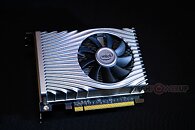Thursday, January 9th 2020

Intel Unveils Xe DG1-SDV Graphics Card, Demonstrates Intent to Seriously Compete in the Gaming Space
At a media event on Wednesday, Intel invited us to check out their first working modern discrete graphics card, the Xe DG1 Software Development Vehicle (developer-edition). Leading the event was our host Ari Rauch, Intel Vice President and General Manager for Graphics Technology Engineering and dGPU Business. Much like gruff developer-editions of game consoles released to developers several quarters ahead of market launch, the DG1-SDV allows software developers to discover and learn the Xe graphics architecture, and develop optimization processes for their current and future software within their organizations. We walked into the event expecting to see a big ugly PCB with a bare fan-heatsink and a contraption that sort-of looks like a graphics card; but were pleasantly surprised with what we saw: a rather professional product design.
What we didn't get at the event, through, was a juicy technical breakdown of the Xe graphics architecture, and its various components that add up to the GPU. We still left pleasantly surprised for what we were shown: it works! The DG1-SDV is able to play games at 1080p, even if they are technically lightweight titles like "Warframe," and aren't maxing out settings. The SDV is a 15.2 cm-long graphics card that relies on the PCI-Express slot for power entirely (and hence pulling less than 75 W).We already know from Intel's Xe slides since 2019 that the Xe architecture is designed to be extremely scalable, with a single ISA scaling all the way from iGPUs to tiny discrete GPUs like the DG1-SDV, and scaling all the way up to double-digit TFLOP-scale compute processors for the HPCs. Along the way, though, Intel intends to compete in the gaming and client-graphics space by developing products at just the right scale of the Xe architecture, with just the right performance/Watt to compete with specific products from the NVIDIA-AMD duopoly. Forget the high-end for a moment. If Intel is able to match even the GTX 1650 and RX 5500 (or their future $150 successors) in performance and power, they end up tapping into a double-digit percentage of the client-graphics TAM, and that spells trouble for Santa Clara and Markham.The Xe DG1 is backed by Intel's robust software stack, which has seen breakneck development and feature-additions in recent times, such as a modern Control Center app, support for modern technologies such as variable-rate shading, integer scaling, etc. Intel has, for over a decade, established a foothold in the client media-acceleration space with its Quick Sync video encoders, and Xe only dials that a notch. The DG1 features Intel's entire media-acceleration and display-controller feature-set. Intel is also designing Xe to be extremely configurable by OEMs, to make the GPU finely-match their product's thermal and power targets. Responding to a specific question by us, Intel didn't rule out the possibility of discrete Xe graphics cards working in tandem with Intel iGPUs (possibly starting with "Tiger Lake").Xe DG1-SDV in action (video)
Here are a couple of brief videos we took of the DG1-SDV alive and kicking.
Here's the card itself:
And here's the money-shot of Intel's presentation, a "Warframe" gaming session. There were no performance numbers put out, but the game is being rendered at 1080p, and appears playable.
Xe DG1-SDV Physical Design
The Xe DG1-SDV (software development vehicle) is a contraption that's more evolved than "working prototype," and stops short of being a production product. It is designed to to be stable and durable enough for its target audience: ISVs, individual software developers, and systems engineers evaluating the thing for major hardware OEMs. The card has the exact same physical dimensions as the Radeon R9 Nano, and fits into any machine that has two full-height expansion slots and a PCI-Express x16 interface, no additional power cables needed. A single fan cools an aluminium fin-stack heatsink underneath. Throughout the demo, the cooler was more than audible and in need of acoustic optimization. The cooler shroud and back-plate bear a futuristic silvery design, there's also a row of LEDs near the I/O shield that put out light into the grooves of the shroud."Tiger Lake" gate-crashes the party
Intel is still trying to break its habit from being a CPU maker foremost. The "Tiger Lake" CPU microarchitecture is a significant inflection point of Intel's next-gen "Willow Cove" CPU core, and the first implementation of Xe as an iGPU solution. Given the volumes of CPUs with iGPUs Intel pushes, Xe is expected to hit critical mass in the client-segment with "Tiger Lake" proving the launchpad. There are some interesting tidbits in the "Tiger Lake" slide:
What we didn't get at the event, through, was a juicy technical breakdown of the Xe graphics architecture, and its various components that add up to the GPU. We still left pleasantly surprised for what we were shown: it works! The DG1-SDV is able to play games at 1080p, even if they are technically lightweight titles like "Warframe," and aren't maxing out settings. The SDV is a 15.2 cm-long graphics card that relies on the PCI-Express slot for power entirely (and hence pulling less than 75 W).We already know from Intel's Xe slides since 2019 that the Xe architecture is designed to be extremely scalable, with a single ISA scaling all the way from iGPUs to tiny discrete GPUs like the DG1-SDV, and scaling all the way up to double-digit TFLOP-scale compute processors for the HPCs. Along the way, though, Intel intends to compete in the gaming and client-graphics space by developing products at just the right scale of the Xe architecture, with just the right performance/Watt to compete with specific products from the NVIDIA-AMD duopoly. Forget the high-end for a moment. If Intel is able to match even the GTX 1650 and RX 5500 (or their future $150 successors) in performance and power, they end up tapping into a double-digit percentage of the client-graphics TAM, and that spells trouble for Santa Clara and Markham.The Xe DG1 is backed by Intel's robust software stack, which has seen breakneck development and feature-additions in recent times, such as a modern Control Center app, support for modern technologies such as variable-rate shading, integer scaling, etc. Intel has, for over a decade, established a foothold in the client media-acceleration space with its Quick Sync video encoders, and Xe only dials that a notch. The DG1 features Intel's entire media-acceleration and display-controller feature-set. Intel is also designing Xe to be extremely configurable by OEMs, to make the GPU finely-match their product's thermal and power targets. Responding to a specific question by us, Intel didn't rule out the possibility of discrete Xe graphics cards working in tandem with Intel iGPUs (possibly starting with "Tiger Lake").Xe DG1-SDV in action (video)
Here are a couple of brief videos we took of the DG1-SDV alive and kicking.
Here's the card itself:
And here's the money-shot of Intel's presentation, a "Warframe" gaming session. There were no performance numbers put out, but the game is being rendered at 1080p, and appears playable.
Xe DG1-SDV Physical Design
The Xe DG1-SDV (software development vehicle) is a contraption that's more evolved than "working prototype," and stops short of being a production product. It is designed to to be stable and durable enough for its target audience: ISVs, individual software developers, and systems engineers evaluating the thing for major hardware OEMs. The card has the exact same physical dimensions as the Radeon R9 Nano, and fits into any machine that has two full-height expansion slots and a PCI-Express x16 interface, no additional power cables needed. A single fan cools an aluminium fin-stack heatsink underneath. Throughout the demo, the cooler was more than audible and in need of acoustic optimization. The cooler shroud and back-plate bear a futuristic silvery design, there's also a row of LEDs near the I/O shield that put out light into the grooves of the shroud."Tiger Lake" gate-crashes the party
Intel is still trying to break its habit from being a CPU maker foremost. The "Tiger Lake" CPU microarchitecture is a significant inflection point of Intel's next-gen "Willow Cove" CPU core, and the first implementation of Xe as an iGPU solution. Given the volumes of CPUs with iGPUs Intel pushes, Xe is expected to hit critical mass in the client-segment with "Tiger Lake" proving the launchpad. There are some interesting tidbits in the "Tiger Lake" slide:
- There's a "massive leap" in graphics performance, compared to current Gen11 architecture, thanks to Xe
- Unless we're badly mistaken, Intel just put out a CPU IPC guidance for "Willow Cove" as being "double digit" (we assume in comparison to current Ice Lake / Sunny Cove)
- A "massive" AI performance improvement from DLBoost and support for more AVX-512 instructions


























44 Comments on Intel Unveils Xe DG1-SDV Graphics Card, Demonstrates Intent to Seriously Compete in the Gaming Space
If these are similarly efficient to Nvidia's cheap mobile Pascal/Turing (1050, 1650) and are well integrated with Intel's mobile platforms, they'll just conquer most of laptop market on day 1.
I believe splitting tasks between IGP and dGPU has already been confirmed (from Tiger Lake onward). AMD has it as well.
Anyway, as mentioned earlier, mobile GPUs seem like the obvious aim. Seriously, why would any laptop maker go with a 1650 or similar Radeon, when they have a solution from the party that provides the CPU? Especially when it would work with the CPU...
For a long time we had higher Nvidia's prices and lower AMD's. Nvidia was making money, AMD wasn't.
Now AMD has raised prices to Nvidia's level, which is just a confirmation of who was right all along.
Intel isn't exactly known for selling at break-even. Don't expect them to be the cheapest option. :)
Seriously, PC gaming is a cheap hobby anyway. Don't be such a miser...
Do we know how GPU sales profile looks by segment?
Guessing by Steam survey, cards up to $300 provide vast majority of sales. Not sure about profits.
This isn't and will never be a major product line for Intel. I doubt they're willing to spend on developing niche high-end cards.
Even AMD, making roughly half of their revenue on GPUs, hasn't always been keen to fight with Nvidia's best.
We walked into the event expecting to see a big ugly PCB with a bare fan-heatsink and a contraption that sort-of looks like a graphics card; but were PEASANTLY surprised with what we saw: a rather professional product design.
This discrete card doesn't look any more powerful than its upcoming mobile counterpart (e.g. Gen12, or Xe-LP or whatever).
Fine for a dev kit, but I don't think it's anything even remotely near a consumer-grade discrete graphics product.
Reviews will be needed before I buy into this.
They are showing precisely one thing - it exists/works.
Wasn't DG1 rumored/revealed to be a 96EU GPU and <25W TDP?
96EU should be 768 shaders so that would make it more of a iGPU size than usual dGPU as we know it.
Might be preparation for Xe reveal in Tiger Lake that should be the same size?
Does this have double-precision FP64? Or would that be limited to the HP and HPC variants?
Though, compared with older HD620/630 I don't see how can it be twice as fast as IceLake graphics, if it's not even close to "+100%" over 9th gen.There were also rumors that the first "desktop" DG1 is a 128EU, but so far no confirmation on this.
It seems like Intel has developed this annoying strategy of releasing or announcing stuff that's not up to snuff just to remind people that they "are doing something" just like that crappy 10nm dual core CPU they released 2 years ago and the "glued" 56 core Xeons. Just doing something isn't good enough.
To all the "bring competition to AMD/Nvidia" prophets, buckle up for some serious disappointment. I have a feeling the purpose of this demo is to sort of like bring down the expectations a bit, there have been some wild hopes and dreams put in Intel's discreet GPUs.